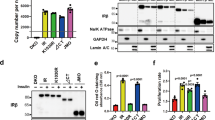Abstract
Two Chinese hamster ovary (CHO) cell lines stably transfected with human insulin receptor cDNA, CHO-wt and CHO-mut, which express an equivalent number of normal and kinase-defective human insulin receptors, respectively, were used to assess the roles of insulin receptor tyrosine kinase activity in insulin-regulated gene expression. The effect of insulin on gene-33-promoter-driven chloramphenicol acetyltransferase (CAT), RSVLTR-driven β-galactosidase (pRSVLTR-βgal) and SV40 late-promoter-driven hepatitis B surface antigen (pMLSV2HBsAg) were examined in CHO-wt and CHO-mut cells. Insulin-stimulated gene 33 promoter is 10- to 50-fold more effective in CHO-wt cells than that in parental CHO cells. However, no enhancement of insulin sensitivity of gene 33 promoter in CHO-mut cells relative to parental CHO cells was found. Similar phenomena were also observed, in that insulin regulated pRSVLTR-βgal and pMLSV2HBsAg in these three CHO lines. Our data indicated that the protein kinase activity of the insulin receptor is essential for the stimulatory activity of insulin toward the activities of different promoters.
Similar content being viewed by others
References
Ausubel FM, Brent R, Kingston RE, Moore DD, Seidman JG, Smith JA, Struhl K. Current Protocols in Molecular Biology. New York, Greene Publishing Associates and Wiley-Interscience, 1987.
Chou CK, Dull TJ, Russell DS, Cherzi R, Lebwohl D, Ullrich A, Rosen OR. Human insulin receptors mutated at the ATP-binding site lack protein tyrosine kinase activity and fail to mediate postreceptor effects of insulin. J Biol Chem 262:1842–1847;1987.
Czech MP. The nature and regulation of the insulin receptor structure and function. Annu Rev Physiol 47:357–381;1985.
Ebina YE, Araki E, Taira M, Shimada F, Mori M, Craik CS, Siddle K, Pierce SB, Roth RA, Rutter W. Replacement of lysine residue 1030 in the putative ATP-binding region of the insulin receptor abolishes insulin and antibody-stimulated glucose uptake and receptor kinase activity. Proc Natl Acad Sci USA 84:704–708;1987.
Ellis L, Clauser E, Morgan DO, Edery M, Roth RA, Rutter WJ. Replacement of insulin receptor tyrosine residues 1162 and 1163 compromises insulin-stimulated kinase activity and uptake of 2-deoxyglucose. Cell 45:721–732;1986.
Ernoult-Iange M, May P, Moreau P, May E. Simian virus 40 late promoter region able to initiate simian virus 40 early gene transcription in the absence of the simian virus 40 origin sequence. J Virol 50:163–173;1984.
Gorman CM, Moffat L, Howard B. Recombinant genomes which express chloramphenicol acetyltransferase in mammalian cells. Mol Cell Biol 2:1044–1051;1982.
Kahn CR. The molecular mechanism of insulin action. Annu Rev Med 36:429–451;1985.
Kasuga M, Karlssor FA, Kahn CR. Insulin stimulates the phosphorylation of the 95,000-dalton subunit of its own receptor. Science 185–187;1982.
Lee KL, Isham KR, Stringfellow L, Rothrock R, Kenney FT. Molecular cloning of cDNAs cognate to genes sensitive to hormonal control in rat liver. J Biol Chem 260:16433–16438;1985.
Messina JL, Hamlin J, Larner J. Positive interaction between insulin and phorbol esters on the regulation of a specific messenger ribonucleic acid in rat hepatoma cells. Endocrinology 121:1214–1227;1987.
Morgan DO, Ho L, Korn LJ, Roth RA. Insulin action is blocked by a monoclonal antibody that inhibits the insulin receptor kinase. Proc Natl Acad Sci USA 83:328–332;1986.
Morgan DO, Roth RA. Acute insulin action requires insulin receptor kinase activity: Introduction of an inhibitory monoclonal antibody into mammalian cells blocks the rapid effects of insulin. Proc Natl Acad Sci USA 84:41–45;1987.
Neumann JR, Morency CA, Russian KO. A novel rapid assay for chloramphenicol acetyl-transferase gene expression. Biotechniques 5:444–447;1987.
Nielsen DA, Chou J, Mackrell AJ, Casadaban MJ, Steiner DF. Expression of a preproinsulin-β-galactosidase gene fusion in mammalian cells. Proc Natl Acad Sci USA 80:5198–5202;1983.
Norton PA, Coffin JM. Bacterial β-galactosidase as a marker of rous sarcoma virus gene expression and replication. Mol Cell Biol 5:281–290;1985.
Russell DS, Gherzi R, Johnson EL, Chou CK, Rosen OM. The protein tyrosine kinase activity of the insulin receptor is necessary for insulin mediated receptor downregulation. J Biol Chem 262:11833–11840;1987.
Stumpo DJ, Stewart TN, Gilman MZ, Blackshear PJ. Identification of c-fos sequences involved in induction by insulin and phorbol esters. J Biol Chem 263:1611–1614;1988.
Tindal MH, Lee KL, Isham KR, Cadilla C, Kenney FT. Structure of a multihormonally regulated rat gene. Gene 71:413–420;1988.
Ullrich A, Bell JR, Chen EY, Herrera R, Peturzzelli LM, Dull TJ, Gray A, Coussens L, Liao YC, Tsubokawa M, Mason A, Seeburg PH, Grunfeld C, Rosen OM, Ramachandran J. Human insulin receptor and its relationship to the tyrosine kinase family of oncogenes. Nature 313:756–760;1985.
Author information
Authors and Affiliations
Rights and permissions
About this article
Cite this article
Lin, S.C., Chen, M.F. & Chou, C.K. Protein kinase activity of the insulin receptor is essential for insulin-regulated gene expression. J Biomed Sci 1, 2–6 (1993). https://doi.org/10.1007/BF02258333
Received:
Accepted:
Issue Date:
DOI: https://doi.org/10.1007/BF02258333




